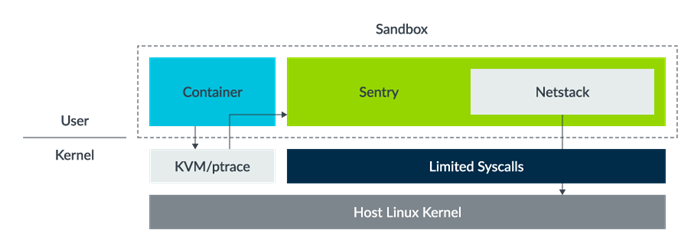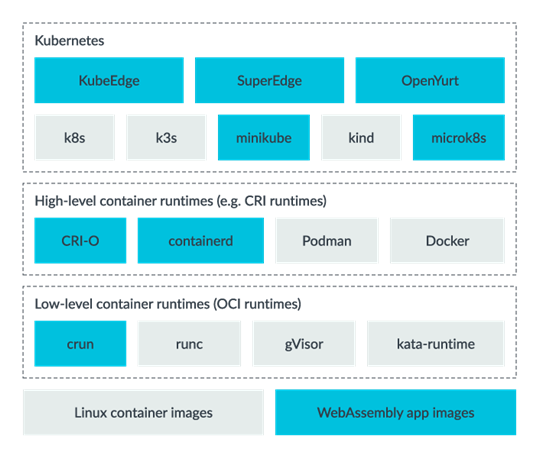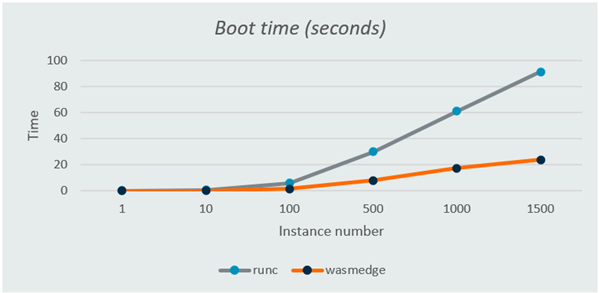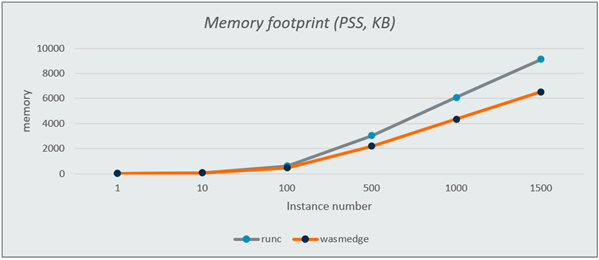

Secure Container Runtimes and Wasm Runtime on Arm - Infrastructure Solutions blo...
source link: https://community.arm.com/arm-community-blogs/b/infrastructure-solutions-blog/posts/container-runtimes-wasmedge-arm
Go to the source link to view the article. You can view the picture content, updated content and better typesetting reading experience. If the link is broken, please click the button below to view the snapshot at that time.

In this blog, I would like to introduce some runtimes on Arm64 platform. Especially, I give you a benchmarking on WasmEdge and Runc, to show you the advantage of Wasm compared with container. Arm consistently makes contribution to open-source projects. We actively participate in the following cloud-native projects that focus on enabling, optimizing performance, and implementing continuous integration and deployment on the Arm64 platform.
Runtimes
A Container runtime is software that is responsible for running containers. Runc is a widely applied runtime and is used by Containerd and Docker by default. There are some other runtimes, such as Crun, Runsc, and Kata containers. Here is the responsibility of a runtime:
- Consuming the container mount point
- Consuming the container metadata (can also be a manually crafted config.json for testing)
- Communicating with the kernel to start containerized processes (clone system call)
- Setting up cgroups, SELinux Policy, App Armor rules
Each runtime has its own adapted areas, like lightweight applications or a Secure environment.
Kata Container
Kata Container is a secure container runtime that uses hardware virtualization technology as an additional layer of defense. This allows it to provide stronger workload isolation while still being lightweight and performing like regular containers.

Image source : https://katacontainers.io/learn/
Moreover, we change the default Virtual Machine Monitor (VMM) from Qemu to Cloud Hypervisor. Compared to Qemu, Cloud Hypervisor is more lightweight and Secure. It is because Cloud Hypervisor has minimal emulated devices and is implemented in Rust to avoid many common security issues.
For more details, please refer to https://katacontainers.io/ and https://www.cloudhypervisor.org/.
gVisor
gVisor is an application kernel, written in Go, that implements a substantial portion of the Linux system call interface. It provides an extra layer of isolation between running applications and the host operating system. It takes advantage of KVM to keep the isolation of memory and CPU between container and host. It also has an application kernel that handles most syscalls in user space, and only a limited number of syscalls would pass to the host kernel. This reduces the attack surface.

Image Source: https://gvisor.dev/blog/2020/04/02/gvisor-networking-security/
For more details, please refer to https://gvisor.dev/.
WasmEdge
WasmEdge is a lightweight, high-performance, and extensible WebAssembly runtime for cloud-native, edge, and decentralized applications.

Image source: https://wasmedge.org/book/en/use_cases/kubernetes.html
WasmEdge uses WebAssembly and WASI. I would not go deep into these two technologies but a general introduction.
- WebAssembly (abbreviated Wasm) is a binary instruction format for a stack-based virtual machine.
- A memory-safe, sandboxed execution environment
- Program languages, like rust, c and Golang, can be compiled into the Wasm binary format that is compatible across all these platforms
- WASI is a modular system interface for WebAssembly. Wasm app interacts with a host kernel through WASI.
For more details, please refer to https://wasmedge.org/book/en/, https://github.com/WebAssembly/WASI, and https://webassembly.org/.
Generally speaking, compared with container technology, Wasm has several pros.
- Smaller binary size and memory footprint
- Some libraries can be shared between Wasm binary.
- Faster start time
- Do not have some startup works in container technology, like creating namespace, cgroup, and so forth.
- Less relay on host kernel
- Container technology needs namespace, cgroup, filesystem, and so forth, but Wasm does not need them.
However, as an unmatured technology, it does have some drawbacks:
- WASI only supports limited syscalls, many applications are not able to migrate to Wasm
- Security of it still needs to be verified
- Many import features are still unimplied. https://github.com/WebAssembly/proposals
These advantages make Wasm quite fit for Serverless and edge computing, which is sensitive to image size or startup time.
A micro-benchmark between WasmEdge and Runc
We do three benchmarks to illustrate the advantage between WasmEdge and Runc, all benchmarks are done on Arm64 server. Here is some information about the testing platform.
| CPU | Ampere(TM) Altra(TM) Processor |
| kernel | 5.17.0 |
| runc | 1.1.4 |
| WasmEdge | 0.11.0 |
The first test verifies the size between normal rust binary (it is used by normal container) and Wasm binary. The following is the code.
fn main() {
println!("hello");
} The normal rust binary is 1.8MB while the Wasm binary is only 0.8MB.

The second test is repeat start the helloworld image that is, runc and WasmEdge for 1, 10, 100, 500, 1000 and 1500 times. As you can see in the second image, the boot time for Wasm is around 25% of that for normal container.

The third test is runs in parallel by starting several helloworld images and making them sleep for a while, then count the memory usage. As you can see in the third image, the memory footprint of 1500 Wasm is 25% less than that of 1500 normal containers.

Summary
In this blog, we give you a general introduction of runtimes, and shows you the benchmark of image size, boot time and memory footprint between runc and WasmEdge.
Here is a table for summaries runtimes in following dimensions, image size, boot time, security, difficulty of app development, project maturity and adapted environment to evaluate.
| runc | Kata/gVisor | WasmEdge | |
| image size | normal | normal | small |
| Bootup time | normal | slow | fast |
| Security | normal | high | unknown |
| Difficulty of App development | normal | normal (debugging within the container is a problem) | high |
| Project maturity | high | high | low |
| adapted environment | Normal usage | Strong isolation needed | Boot time or memory size sensitive |
If you are interested in these runtimes, you can visit their official websites to obtain more detailed information.
WasmEdge: https://wasmedge.org/
WebAssembly: https://webassembly.org/.
Kata Containers: https://katacontainers.io/
Cloud Hypervisor: https://www.cloudhypervisor.org/.
gVisor:https://gvisor.dev/.
Recommend
-
 52
52
README.md Sucrase
-
 58
58
Introducing App Engine Second Generation runtimes and Python 3.7 2018-08-09adminUncategorized
-
 45
45
Announcing Cloud Tasks, a task queue service for App Engine flex and second generati...
-
 55
55
Key Takeaways Container runtime choices have grown over time to include other options beyond the popular Docker engine The Open Container Initiative (OCI) has successfully standardi...
-
 31
31
WASM: universal application runtime Last summer, fresh off my last freelance gig, I was catching up with my friend Asim , the founder of the widely popular
-
 7
7
上一篇文章分享了wasmer runtime,编译好的openssl.wasm文件可以独立运行,这篇文章分享openssl.wasm和原生openssl之间的性能对比。 测试硬件 主机 MacBook Pro CPU 6-Core Intel Core i7 2.2 GHz/...
-
 7
7
README.md PHP Runtimes In early 2021, Symfony created a "Runtime component". This component may look complex, weird and full of hacks but it is a g...
-
 403
403
Colima Container runtimes on macOS with minimal setup. Features Simple CLI interface Docker and Containerd support Port Forwarding Volume mounts Kubernetes Gettin...
-
 3
3
Session video from DevOpsCon Video: Think Container Orchestration Different — Wasm Is Coming DevOps
-
 3
3
[:arrow_down: Download] [:book: Command reference]...
About Joyk
Aggregate valuable and interesting links.
Joyk means Joy of geeK